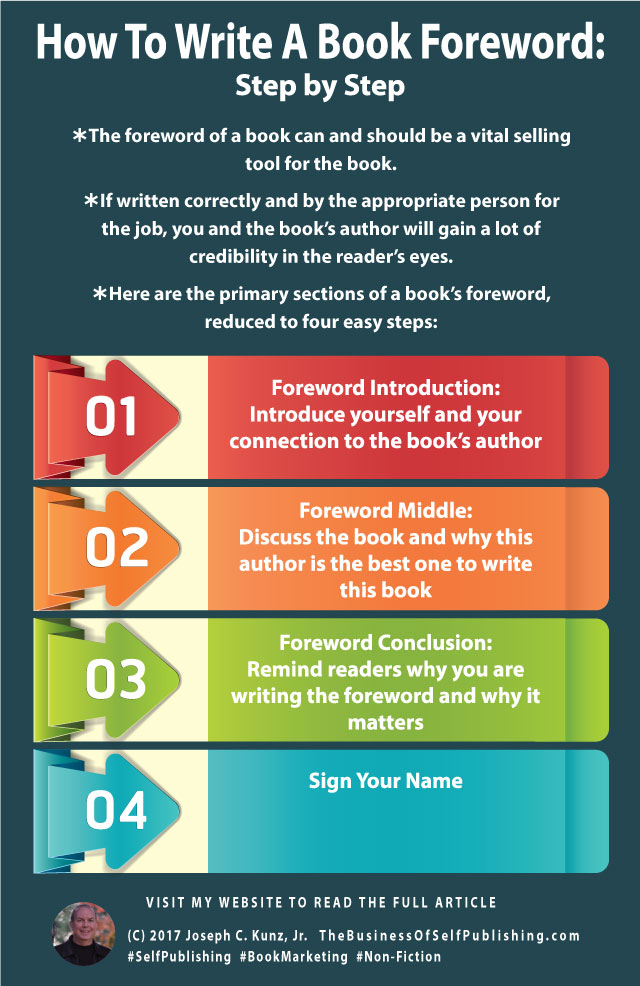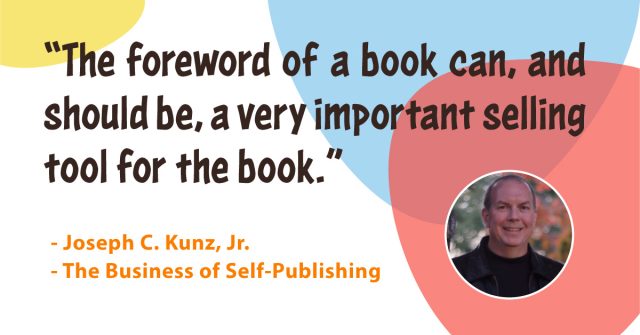Podcast: Play in new window | Download
Subscribe: Apple Podcasts | Spotify | Pandora | RSS | More
Updated February 22, 2024
Subtitle
A well-written foreword can help you sell more books
Synopsis:
How to create and write a powerful book foreword that will help build your credibility and status, AND help the book’s author sell more books. I show you how to write the book foreword in four easy steps.

What You Will Learn
1. You will learn why the foreword is an essential selling tool for the book.
2. You will learn how the foreword helps establish credibility for the author and the book.
3. You will learn to create a book foreword in four easy steps.
Introduction
A. The Foreword Is an Important Selling Tool
The foreword of a book can and should be a vital selling tool for the book. If written correctly and by the appropriate person for the job, you and the book’s author will gain a lot of credibility in the reader’s eyes. I have assembled some information about the foreword to give you a basic idea about what should typically be included.
It is important to remember that the book’s author usually should not write the foreword. Instead, the book’s author can use the Preface and the Introduction to say what needs to be told about the book.

B. The Foreword Establishes Credibility
Forewords introduce the reader to the author and the book and attempt to establish credibility for both. A foreword does not generally provide the reader extra specific information about the book’s subject but instead serves as a reminder of why the reader should read the book.
Writing a foreword can be a lot of work, but it can prove beneficial for the author of the foreword and the book’s author. With the foreword, you are trying to connect emotionally with the reader. You want the reader to like you and your story. This emotional connection will help the reader believe and trust what you have to say about the book’s author and itself.
C. The Typical Foreword Is Short and to the Point
Typically, a foreword is one to two pages – 750 to 1,500 words. As the author of the foreword, you can go longer if you have an exciting story to tell about the book’s author or the book itself. There should be four sections of a foreword: the introduction, the middle or main body, the conclusion, and the name of the foreword’s author.
Here are the primary sections of a book’s foreword, reduced down to four easy steps:
Step 1. Foreword Introduction:
The first section should introduce yourself in a few short sentences and then describe your connection with the author and the book. If you don’t know the author personally, explain how important the book’s message is for the reader.
Making a foreword personal also lets the reader make an emotional connection. Remind readers who you are. Tell them why you are famous. Tell them why you are the right person to be writing the foreword for this book. This explanation provides credibility to the author of the book.
Step 2. Foreword Middle:
Discuss the book and why this author is the best one to write this book
The middle section should explain the contents and benefits of the book to the reader. The reader should know why the book is relevant to him. Therefore, you should give the reader an intriguing reason why this book is unique or meaningful.
Connect the text to experiences that a reader might face in everyday life. Mention the good points about the book and what the readers will get from reading it. Connect the book to experiences that a reader might face in everyday life.
Mention the good points about the book and what the readers will get out of reading it. Be sure to give a very brief synopsis of the book. Try to use short anecdotes about the book and the author.
Be sure to give a very brief synopsis of the book. Try to use short anecdotes about the book and the author. These anecdotes can be anything from a chance meeting with the author to realizing that the book could help you solve a problem.
Try to include a real-world example that illustrates the theme of the book. These stories are a way to show the reader that the book’s author is credible on the subject matter.
Step 3. Foreword Conclusion:
Remind readers why you are writing the foreword and why it matters
In the conclusion of the foreword, remind the readers why you are writing the foreword and why it matters. This explanation is vital for both the author’s and your own careers.
For the author, it will boost the book’s credibility and help sell more copies. For you, it will remind the public of your career and improve your credibility for your next book or article.
Bring the foreword full circle. If possible, you should reference something from your first paragraph in your final paragraph. This will add cohesiveness to your foreword. This discussion will motivate readers to continue reading the book because you, the expert, tell them it is worth reading.
Step 4. Sign Your Name
Type your name at the bottom of the foreword. After your name, add your title. If you have several titles, add the most relevant one. You can also add the title of the most recent or most famous book that you have written. Then add the city where you live and the year.

Conclusion
You must remember that the foreword of a book is an essential selling tool for the book. It must be short and concise. It must establish credibility for the author and the book. You can help make the reader want to read the book by creating an emotional connection with the reader. Talk to the reader as if you were talking to a friend. Keep it engaging and tell an exciting story. All of this will play an essential role in helping to improve book sales.
Questions to Think About
1. Have you ever been asked to write a book foreword? Was it from a colleague, friend, etc.?
2. Did you read the entire book before or after you agreed to write it?


